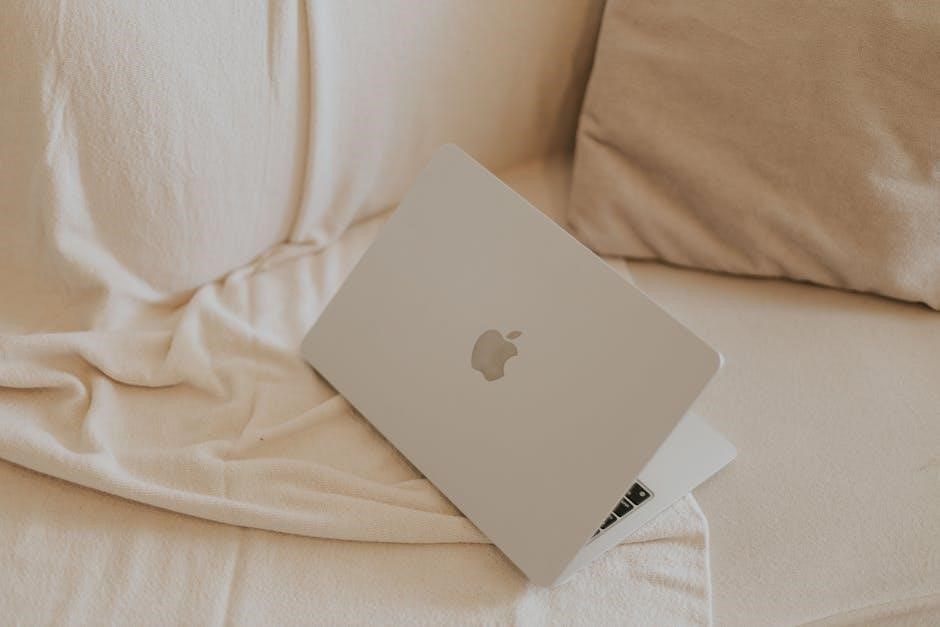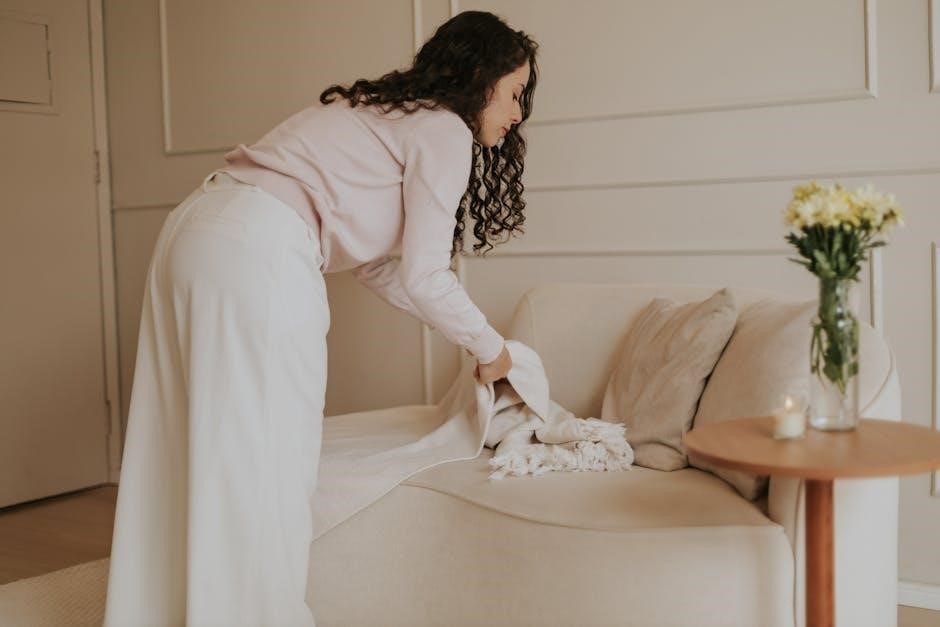Minky blankets are celebrated for their luxurious softness and warmth, making them a favorite for both babies and cozy home decor. Proper care ensures their plushness endures, providing lasting comfort and style.
Why Proper Washing is Essential for Minky Blankets
Proper washing is crucial to maintain the softness and luxurious feel of minky blankets. Improper techniques, such as using hot water or harsh detergents, can damage the delicate fibers, causing them to lose their plushness or even mat together. Regular washing removes dirt, oils, and germs that can degrade the fabric over time. Without proper care, minky blankets may shed excessively or become stiff, reducing their comfort and aesthetic appeal. Following the right washing methods ensures the blanket remains cozy and retains its vibrant texture for years to come. Neglecting care instructions can lead to irreversible damage, making proper washing a necessity.
Overview of Minky Fabric and Its Unique Properties
Minky fabric is a soft, luxurious material often used in blankets, known for its plush texture and warmth. Made from synthetic fibers, typically polyester, it mimics the feel of velvet or suede, offering exceptional comfort. Its unique properties include a dense pile that traps heat, making it ideal for cozy bedding. However, minky fabric requires gentle care to preserve its softness. Heat and harsh chemicals can damage the fibers, leading to loss of texture or shedding. Proper washing and drying techniques are essential to maintain the fabric’s integrity and extend its lifespan. Understanding these properties ensures minky blankets remain a cherished, durable companion for years.
Pre-Washing Instructions for Minky Blankets
Always check the care label for specific guidance and prepare the blanket by removing loose dirt or debris before washing to ensure optimal cleaning and preservation.
Checking the Care Label for Specific Guidance
Before washing your minky blanket, always check the care label for specific instructions, as different materials or finishes may require unique attention. The label will provide guidance on whether the blanket can be machine washed, hand washed, or must be dry cleaned. It may also specify recommended water temperatures, cycle settings, and detergents to use or avoid. Some minky blankets may require cold water only or prohibit the use of fabric softeners and bleach. Following these guidelines ensures the blanket retains its softness and plush texture. Ignoring the care label could lead to damage or loss of the blanket’s luxurious feel, so it’s crucial to adhere to the manufacturer’s advice.
Preparing the Blanket for Washing
Before washing, inspect the minky blanket for stains or loose debris and gently brush it to restore softness. Check for any loose threads or items in pockets that could damage the blanket during washing. Pre-treat any visible stains with a mild detergent or a mixture of white vinegar and baking soda. Ensure the blanket is free of any attachments or accessories that could interfere with the washing process. Proper preparation helps maintain the blanket’s quality and prevents damage during cleaning. This step ensures the blanket is ready for a gentle wash, preserving its plush texture and extending its lifespan.
Removing Loose Dirt or Debris
Before washing, gently remove any loose dirt or debris from the minky blanket using a lint roller or a soft-bristled brush. This prevents particles from embedding deeper into the fabric during the wash cycle. For superficial stains or spills, dampen a clean cloth with cold water and blot the area gently without rubbing. Avoid using harsh scrubbing motions, as they can damage the delicate minky fibers. If debris is stubborn, consider hand-picking it or using a sticky roller to lift it away. Removing loose dirt ensures a more effective wash and helps maintain the blanket’s soft, luxurious texture. Regular maintenance keeps it clean and pristine.

Washing Your Minky Blanket
Washing your minky blanket requires gentle care to preserve its softness and texture. Always use cold water and a delicate cycle to prevent fiber damage. Choose a mild detergent free of harsh chemicals, and avoid fabric softeners or bleach, as they can leave residue and reduce plushness. Wash the blanket alone to prevent snagging or color transfer. Place it in the washing machine with the detergent, ensuring no other items are included. Gently agitate the water to distribute the detergent evenly. After washing, remove promptly to avoid creasing. Proper washing maintains the blanket’s luxurious feel and extends its lifespan.
Choosing the Right Detergent for Minky Fabric
When washing your minky blanket, selecting the right detergent is crucial to maintain its softness and texture. Opt for a mild, gentle detergent that is free from harsh chemicals, bleach, and fabric softeners. These additives can leave a residue on the delicate minky fibers, reducing their plushness and softness. Look for detergents labeled as “eco-friendly,” “clear,” or “suitable for sensitive skin,” as these are typically designed for gentle cleaning. Avoid using detergent pods, as they can release too much concentrated detergent. Using a mild liquid or powder detergent ensures your minky blanket remains soft, clean, and retains its luxurious feel after washing.
Using Cold Water and Gentle Cycles
Washing your minky blanket in cold water is essential to preserve its softness and prevent damage to the delicate fibers. Cold water ensures the blanket retains its plush texture and vibrant colors. Gentle cycles are also crucial, as aggressive washing can cause mechanical stress, leading to shedding or loss of softness. Heat from hot water can melt the polyester fibers, causing them to clump or lose their luxurious feel. Always select the coldest and most delicate setting on your washing machine to protect your minky blanket. This approach ensures the blanket remains cozy, soft, and maintains its original quality after each wash.
Why Fabric Softeners and Bleach Should Be Avoided
Fabric softeners and bleach should never be used when washing minky blankets. Fabric softeners leave a residue on the fine polyester fibers, reducing their softness and plushness over time. Similarly, bleach is harsh and can damage the delicate fabric, causing it to become brittle or discolored. These chemicals can also weaken the fibers, leading to premature wear and tear. To maintain the blanket’s luxurious texture, it’s best to use mild detergents without any additional softening agents or harsh chemicals. This ensures the minky blanket remains soft, vibrant, and durable for years to come, preserving its cozy comfort and appeal.
Washing the Blanket Alone to Prevent Damage
Washing your minky blanket alone is crucial to prevent damage and maintain its softness. Other fabrics, especially those with zippers or buttons, can snag or tear the delicate minky fibers during the wash cycle. Additionally, washing the blanket with other items can lead to color bleeding or the transfer of lint and residue, which may dull the fabric’s plush texture. Washing it separately ensures the blanket remains intact and retains its luxurious feel. This practice also prevents the buildup of residue from other fabrics, which can affect the blanket’s softness over time. Always prioritize washing your minky blanket alone to protect its integrity and keep it looking its best.

Drying Your Minky Blanket
Air drying is recommended to preserve softness, but low heat settings are acceptable. Remove the blanket while damp to prevent wrinkles and maintain its plush texture effectively.
Air Drying vs. Machine Drying: Best Practices

Air drying is the preferred method for minky blankets as it preserves their softness and prevents damage from heat. Lay the blanket flat on a drying rack or hang it outside in a shaded area. If using a machine, opt for a low heat or air fluff setting. Remove the blanket while still damp to avoid wrinkles and allow it to finish drying naturally. This gentle approach ensures the fibers remain intact, keeping the blanket plush and cozy for years to come.

Using Low Heat Settings in the Dryer
If air drying isn’t feasible, using a dryer on a low heat setting is the next best option for minky blankets. High heat can damage the delicate fibers, so selecting a gentle cycle with minimal heat is crucial. Remove the blanket while it’s still slightly damp to prevent wrinkles and ensure it retains its plush texture. For optimal results, consider using the “air fluff” or “tumble dry” setting without heat. This method helps maintain softness and prevents fiber breakdown, keeping your minky blanket cozy and intact for years to come.
Removing the Blanket While Still Damp
Removing the minky blanket from the dryer while it’s still damp is essential to maintain its softness and prevent wrinkles. Once the cycle ends, take it out immediately and gently shake it to restore its shape. Hanging it over a clothes rack or laying it flat allows it to air dry completely, preserving the plush texture. Avoid leaving it in the dryer until fully dry, as residual heat can damage the fibers. This step ensures the blanket remains soft, luxurious, and free from wrinkles, keeping it cozy and comfortable for years to come.
Preventing Wrinkles and Maintaining Softness
Preventing wrinkles and maintaining softness in minky blankets requires careful attention during drying and storage. After washing, remove the blanket while still damp and gently shake it to restore shape. Hanging it over a clothes rack or laying it flat to air dry is ideal, as heat from dryers can damage fibers. Avoid ironing, as high heat can ruin the fabric. Instead, smooth out wrinkles by hand or lightly brushing the blanket. Storing it in a cool, dry place, folded neatly or draped over a surface, helps preserve softness and prevent creases. Regular brushing can also maintain the plush texture, ensuring your minky blanket stays cozy and luxurious.

Stain Removal and Spot Cleaning
For effective stain removal, identify the stain type, apply mild detergent or a white vinegar and baking soda mixture, then gently blot with a damp cloth.
Identifying Common Stains on Minky Fabric
Common stains on minky fabric include food spills, dirt, and oil from skin, which can break down its softness. Pet accidents and ink stains are also frequent issues. These stains can dull the fabric or leave unwanted odors. Identifying the type of stain is crucial for effective removal. Food and drink spills should be addressed immediately to prevent them from setting. Dirt and dust can accumulate over time, especially on frequently used blankets. Oil-based stains, like those from skin or lotions, may require special treatment. Always blot spills gently with a damp cloth to avoid damaging the delicate fibers. Prompt action helps maintain the blanket’s plushness and appearance.
Applying Mild Detergent Directly to Stains
For effective stain removal on minky fabric, apply a small amount of mild detergent directly to the stained area. Gently blot the stain with a damp cloth, working from the outside in to avoid spreading it. Avoid rubbing or scrubbing, as this can damage the delicate fibers. Use a detergent labeled as eco-friendly or suitable for sensitive skin, as harsh chemicals can leave residue. Let the detergent sit for a few minutes before washing the blanket in cold water on a gentle cycle. This method ensures the stain is treated without compromising the softness or texture of the minky fabric.
Using White Vinegar and Baking Soda for Tough Stains
For stubborn stains on minky fabric, a mixture of white vinegar and baking soda can be an effective solution. Combine 1 cup of white vinegar with 1 tablespoon of baking soda to create a paste. Apply this mixture directly to the stained area and let it sit for about 10 minutes. Gently blot the stain with a damp cloth, working from the outside in to avoid spreading it. This method helps break down the stain without damaging the delicate fibers. After treating, wash the blanket in cold water on a gentle cycle. This natural approach restores softness and removes tough stains without harsh chemicals.
Gently Blotting Stains with a Damp Cloth
When addressing stains on minky fabric, gently blotting with a damp cloth is essential to preserve its softness. Dampen a clean cloth with cold water and gently press it onto the stained area. Avoid rubbing, as this can damage the fibers or push the stain deeper. Instead, blot from the outside inwards to contain the stain. Repeat this process until the stain lightens. For tougher stains, apply a small amount of mild detergent directly before blotting. This method ensures the fabric remains intact and maintains its plush texture. Always avoid using hot water, as it can harm the minky fibers and reduce their softness over time.

Maintenance and Storage Tips
Store your minky blanket in a cool, dry place to preserve its softness. Brushing it gently can help maintain its plush texture over time.
How Often to Wash Your Minky Blanket
The frequency of washing your minky blanket depends on its usage. If used frequently, it’s recommended to wash it every 1-2 weeks to remove dirt, oils, and germs. For less frequent use, washing every 4-6 weeks is sufficient. Over-washing can degrade the fabric, so it’s important to balance cleanliness with fabric care. Always check for visible stains or odors to determine if a wash is needed. By adhering to this schedule, you’ll maintain the blanket’s softness and extend its lifespan. Proper washing habits ensure your minky blanket remains a cozy and hygienic companion.
Brushing the Blanket to Maintain Softness
Gently brushing your minky blanket is an effective way to maintain its softness and restore its plush texture. Use a soft-bristle brush or a lint roller to remove loose fibers and prevent matting. Brushing also helps redistribute the fabric’s natural oils, keeping it feeling luxurious. For best results, brush the blanket after washing and drying, working in one direction to avoid tangling. Regular brushing not only enhances softness but also extends the blanket’s lifespan by preventing pilling and fraying. This simple step ensures your minky blanket remains cozy and visually appealing for years to come.
Storing the Blanket in a Cool, Dry Place
Proper storage is essential to maintain the softness and appearance of your minky blanket. Store it in a cool, dry place away from direct sunlight to prevent fading and heat damage. Avoid damp or humid environments, as moisture can lead to mildew or odor. Fold the blanket neatly and place it in a breathable fabric bag, such as cotton, to allow airflow and protect it from dust. Do not store it in plastic bags or airtight containers, as this can trap moisture and damage the fabric. By storing your minky blanket correctly, you preserve its plushness and ensure it remains cozy for years to come.

Troubleshooting Common Issues
If your minky blanket sheds or loses softness, use a lint roller and avoid heat. For wrinkles, air dry or use low heat; never iron;
What to Do If the Blanket Sheds or Loses Softness
If your minky blanket begins to shed or loses its softness, gently remove loose fibers with a lint roller. Avoid using fabric softeners or heat, as these can damage the fabric. Wash the blanket in cold water with a mild detergent and air dry to restore its plushness. Adding a mixture of white vinegar and baking soda during washing can also help soften the fibers. Regular maintenance, such as brushing the blanket, can prevent shedding and maintain its luxurious feel.
Fixing Wrinkles Without Using an Iron
To remove wrinkles without using an iron, lay the blanket flat on a clean surface or hang it to air dry after washing. High heat can damage the delicate minky fibers, so avoid ironing altogether. If wrinkles persist, gently smooth the fabric with your hands or use a steamer on a low setting. For best results, air dry the blanket on a clothes rack or line, allowing it to relax naturally. This method ensures the blanket retains its softness and plush texture without risking heat damage.
Reviving the Blanket’s Plushness After Washing
After washing, reviving your minky blanket’s plushness is easy. Air dry it on a rack or hang it outside, ensuring it doesn’t come into contact with direct heat. Once dry, gently brush the fabric with a soft-bristle brush or your hands to restore its fluffiness. For extra softness, wash the blanket with a mixture of white vinegar and baking soda. This natural solution helps remove residue and rejuvenate the fabric’s texture. Regular brushing and avoiding fabric softeners also maintain the blanket’s luxurious feel, ensuring it stays soft and cozy for years to come.
By following proper washing and drying techniques, your minky blanket will remain soft and plush. Regular care and gentle handling ensure its luxurious comfort lasts for years to come.

Summarizing the Best Practices for Washing Minky Blankets
For optimal care, wash minky blankets in cold water using a gentle cycle and mild detergent. Avoid fabric softeners and bleach, as they can damage the fabric. Washing the blanket alone prevents friction and color bleeding. Air drying is recommended to maintain softness, but if using a dryer, choose a low-heat setting and remove it while still damp. Regular brushing helps preserve the blanket’s plush texture, and storing it in a cool, dry place prevents moisture buildup. Following these steps ensures your minky blanket remains soft, luxurious, and long-lasting. Proper care is essential to enjoy its comfort and beauty for years to come.

Encouraging Readers to Follow Care Instructions
Adhering to proper care instructions is crucial to maintain the softness and durability of minky blankets. Neglecting these guidelines can lead to damage, such as shedding or loss of plushness. By following the recommended washing and drying methods, readers can ensure their blankets remain cozy and vibrant. Consistent care not only preserves the blanket’s quality but also extends its lifespan, providing continued comfort and enjoyment. Encourage readers to take the extra time to follow these simple steps, as the effort will be rewarded with a blanket that stays soft and luxurious for years to come. Proper care is a small investment for long-lasting comfort.
Additional Resources for Minky Blanket Care
For further guidance on maintaining your minky blanket, explore online resources like WikiHow’s detailed washing guide or Kalin Marie’s care tips. These sources offer comprehensive advice, including stain removal and fabric softness restoration. Additionally, manufacturers often provide specific care instructions tailored to their products. Reading blogs or watching tutorials by experts like Brian Severson can also offer practical insights. Utilizing these resources ensures you’re equipped with the best practices to keep your minky blanket in pristine condition. Always refer to reliable sources to address specific concerns and maintain your blanket’s softness and appearance over time.